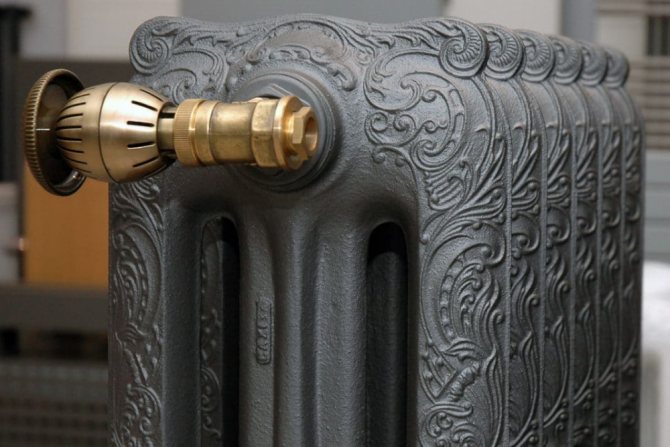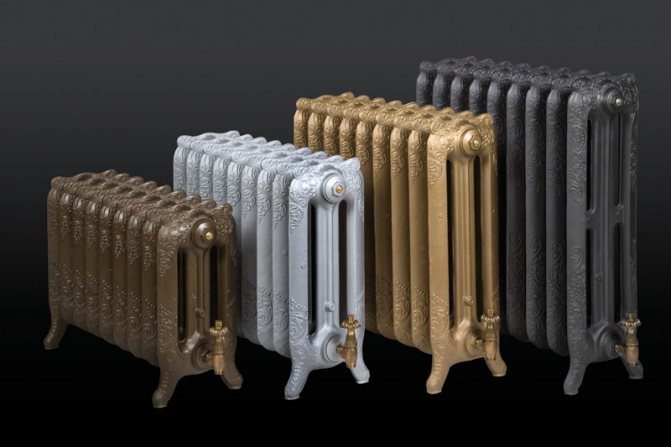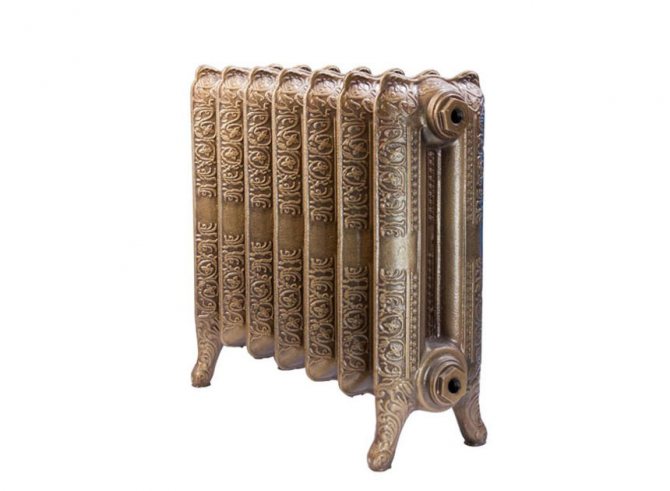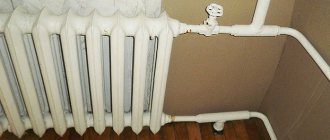Modern batteries are attracting the attention of homeowners for their increased heat dissipation capability. At the same time, it is hardly possible to call them a decoration of stylish interior design. Often it is necessary to hide radiators behind decorative grilles and screens, thereby reducing the efficiency of the heating system.
Today manufacturers offer a wide variety of design forms of modern retro-style cast iron radiators. An overview of the models will help you make your choice.
Features of retro cast iron batteries
Cast iron batteries can look like steel and aluminum in a modern industrial style. But the main advantage of the devices lies in the stylistic variety of section shapes and relief patterns on the cast surface.

Benefits
There are countless types of cast iron heat exchangers. You can choose the right device for almost any interior. Moreover, the trivial heating battery becomes a separate original stylistic accessory.
Cast iron batteries have a number of other advantages:
- Maintenance-free throughout the entire service life.
- Massiveness and large internal volume increase the thermal inertia of the heating system. This is ideal for use in combination with warm floors.
- Cast iron is resistant to corrosion, so thick walls will not rust even after fifty years of operation.
- A variety of section sizes and connecting center distances allows you to easily select batteries for almost any interior.
- Large internal cavities are not clogged with mud.
- The reliability of the design allows you to operate the steam heating system at a coolant temperature of up to 150 degrees Celsius.
- Manufacturers give a guarantee for 10-15 years, but the actual service life most often exceeds half a century.
- Cast iron appliances are equally effective in heating systems with forced and natural circulation of the coolant.
- Products are painted at the factory. High-quality enamel is resistant to mechanical damage, does not tarnish, does not crack from multiple temperature changes.
In summer, the heating system must be filled with coolant to avoid air ingress and corrosion of metal surfaces. In practice, due to low-quality stop valves, repair work, water flows out, and the metal rusts faster. Only cast iron sections successfully cope with this problem.


disadvantages
It is necessary to install cast-iron heaters taking into account their shortcomings. First of all, you should pay attention to the strength of the walls. If it is not possible to securely fix the brackets for suspended structures, then floor-type radiators should be chosen.
Other disadvantages:
- automatic temperature control systems must be adapted to the inertia of cast iron batteries;
- when used together with underfloor heating, it is required to connect the heaters to a higher-temperature heat source;
- the working pressure in the heating network must be within 4–6 bar;
- large internal volume affects the increase in the time of filling the system with water;
- inclined and horizontal stiffeners contribute to the accumulation of dust;
- heavy weight makes transportation and installation difficult;
- retro-style products are more expensive than aluminum and steel.
When designing heating using retro radiators on legs, special channels should be provided under the floor for laying pipes.They must be as reliable as possible, since visual inspection of leaks will be impossible.


Characteristics of retro batteries
The range of designer cast-iron radiators is wide: you can choose a heating device for almost any interior. The radiator can be painted in any shade, have beautiful patterns or be monochromatic, have a different number of sections and legs of different shapes.
The cast iron unit is completely protected from various harmful impurities in the water. You do not need to fill the system with a special coolant, but use ordinary tap water.
With the help of such devices, you can effectively heat even the coldest rooms, because a cast iron radiator can operate smoothly at a water temperature in the pipes of 110 degrees. The temperature is kept for a very long time due to the distribution of energy output: a third goes away by convection, that is, by the return of heated air, and the rest by radiation.
Old heating devices are restored by covering the cast-iron surface with a primer or epoxy resin, which allows the device to be repainted in any color. The whole procedure can be done by hand. Negative sides:
- very high weight in comparison with aluminum - at least 6 kg of weight per section;
- due to the shape of the device, it is difficult to clean - the walls of the sections are located very close to each other, and it is difficult to slip a rag between them;
- the surface is rough, which makes it easy for dust and dirt to accumulate on it.
Comparison with other types of batteries
Taking into account the lower cost of more technologically advanced heating devices made of steel and aluminum, one must take into account their lower durability. They rust from the inside faster, so they will have to be replaced more often in a major overhaul. Retro cast iron radiators are a great option for rooms decorated in the old style with finishes made of precious woods, marble, and expensive accessories.
Does it make sense to change the design, which has been proven by many decades of good service. The principle of operation and the internal structure of cast iron batteries have remained almost the same as a hundred years ago. But when there is a need to replace reliable heating devices with more modern ones, you need to pay attention to alternative options.
Heaters are made from the following materials:
- aluminum;
- steel;
- bimetal;
- cast iron.
Aluminum creates galvanic pairs with other conjugated metals. This greatly accelerates corrosion and reduces the trouble-free service life. In bimetallic radiators, this drawback is especially pronounced.
With a periodic method of heating using units for burning solid fossil fuels, massive radiators retain heat longer. On the other hand, with the use of aluminum or steel batteries, you can warm up the room faster.
Modern heating devices have other advantages over cast iron:
- improved thermal conductivity;
- small inertia;
- less weight for easier installation;
- minimum internal volume for the coolant;
- low cost.
The design features of steel and aluminum batteries allow you to build in individual thermostats that automatically select the most economical mode for heating the room. In this case, it is necessary to monitor the quality state of the coolant: install filters, soften water using chemical reagents.
In summer, the system must be completely filled with water. If the liquid leaks out, then in conditions of humidity and oxygen access, corrosion processes will be significantly accelerated, the metal will rust, and you will have to make a major overhaul ahead of time with the replacement of individual sections or radiators.


Selection of cast-iron retro radiators with a miscalculation of power
When choosing equipment for a modern home, it is important to familiarize yourself with the technical description for the model. The heat output must be indicated there.
It is logical that a 7-section ugun radiator will have less power than 12; in the description of the device, indicators for 1 section are often indicated. Standard "MC 140" for an apartment - 7-8 sections for a bedroom or a nursery, 9-12 is enough for a 3x9 living room or a standard hall of 16-20 sq. m.
For a wall made of foam concrete (another light material), it is better to choose options with legs. The most important characteristics:
- height, width and depth of sections;
- Efficiency (power).


Cast iron battery on legs
They switch to the choice of design and format, having decided on the indicators of thermal power - this is the ratio of the efficiency of the battery and the heated volume per unit of time. There are special programs for calculations for non-standard premises:
- two-storey cottage;
- loft apartments;
- studio apartment;
- large-scale building without partitions.
When choosing a model, it is important in which niche the cast-iron retro heating radiator will be installed. The standard for distances to adjoining walls and floors must be adhered to. It is important that cold air masses flowing from the windowsill onto the radiator are quickly distributed over the metal surface.
Selection recommendations
The price of cast-iron retro batteries depends on the design - the complexity of the cast surface, the bas-relief pattern, the quality of the painting.
The technical characteristics of the radiators matter:
- height;
- width;
- section depth;
- the amount of heat output.
The maximum durability of the painted surface can only be achieved if certain conditions are met. After applying special dyes, the products are placed in heat chambers for drying at high temperatures and controlled humidity. At home, it is impossible to repeat this technology, so it is more profitable to purchase cast iron batteries ready for installation.
For the initial calculation of the number of devices, the specific power factor of the heating system is used, which is taken equal to 100 W / m2. If the area of the room is 90 m2, then 9000 W of heat will be required. If the average thermal power of one section is 150 W, then you will need to buy 60 sections. They are connected and placed most often under the windowsills. If there are six windows with the same dimensions, then you get 6 heating devices from 10 sections.
When calculating the required number of heating radiators, specific climatic conditions must be taken into account. It is obvious that winter frosts are stronger in the Arctic Circle than in the central part of Russia. Calculations are made for each room separately. Then a safety factor is added to the power of heating devices, which is 10-15%.
Criterias of choice:
- The design of the battery should match the interior of the room.
- Cost is often the deciding factor.
- Heat dissipation directly affects the number of batteries. The greater the efficiency of the radiator, the fewer sections will be required.
- The manufacturer must guarantee the reliability.
- Durability of cast iron radiators (time-tested).
- The size depends on the number of sections, as well as on the height of the window sill, where the batteries are most often installed.
- Weight is only important during transport and preparation for installation. If the walls are made of lightweight concrete, then you need to choose the floor version with legs.
For heating a cottage, the operating pressure in the system is insignificant, and in multi-storey buildings it reaches high values. It is worth considering this factor and looking at the permissible pressure specified by the manufacturer in the product passport.


Advantages and disadvantages
The undoubted and main advantage of "retro" style radiators is their appearance, configuration and design, which allows them to take pride of place in the interior of any room.As a matter of fact, they were created for this purpose, no other type of batteries can boast of such dignity. There are other benefits as well:
- durability: arises from the properties of cast iron to resist corrosion and calmly endure long-term contact with the most aggressive heat carrier. Hence, the service life of the product is up to 50 years;
- reliability: new cast-iron retro radiators have a higher threshold of the maximum allowable pressure, and therefore can be installed almost everywhere, except for multi-apartment high-rises;
- inertia: massive heating devices cool down slowly, however, as they heat up. So this dignity should be considered as twofold.
Of the shortcomings, the high price stands out immediately: it is twice, or even three times higher than that of the aluminum "brothers". In addition, the batteries are lightweight and contain quite a lot of coolant. Because of this, inertia arises, which does not allow the use of thermostatic valves for regulation. The fact that classic cast-iron radiators still lose in heat transfer was mentioned above. It turns out that the number of sections for the same room in comparison with bimetallic devices will be greater, as a result of which the price of the assembled radiator will additionally increase.
Retro radiator manufacturers review
High-quality cast-iron casting, the original shape of the sections, the stylishness of the patterned ornament create the unique attractiveness of the new model of cast-iron batteries. Their price is higher than that of standard models. At the same time, the old design of heating devices organically complements the classic, Gothic or English style of room decor.
You can buy retro cast iron radiators in a budget version or order an exclusive design with a bas-relief ornament, patina or artificial aging of the surface. The cost of products is strongly influenced by the scale of production. Some models are made only to order, which significantly increases their price. Especially when compared with the cost of standard Soviet-style products. For example, one section of the Russian-made MS-140 can be purchased for 380 rubles.


Retro style
A Russian brand that manufactures several collections of cast iron radiators in various styles: Empire, Rococo, Classicism, Baroque. The company provides a service of ordering the coloring of batteries according to the preference of the client. You can choose imitation of antique silver, gzhel, red gold, bronze and other options.
The cost of one section of a vintage two-channel Retro Style Anerli is 16367 rubles.


A battery of 5 low-profile multichannel sections Retro Style Bolton can be purchased for 19,219 rubles.


The cast iron radiator Retro Style Chester costs 41,696 rubles for 5 sections.


Prices for Retro Style cast iron radiators
cast iron radiators Retro Style
Guratec
The high-quality heaters made in Germany are designed in a retro style. The surface of the sections is protected with powder paint, resistant to mechanical damage. Products are tested on hydraulic stands before being sent to consumers.
The Guratec radiator from the Fortuna series, which costs from 140 euros per section, is decorated with beautiful ornaments of grapevine, images of dragons, lions and angels. The patterned surface of the batteries painted in the color of the decor will adorn the classic interior.


Prices for cast iron radiators Guratec
cast iron radiators Guratec
Roca
The representative of the Spanish industry has a century of development. The first products were produced by the plant in 1917. Produces a wide range of radiators in aluminum, steel and cast iron with a retro design. The Epoca model is popular - a battery of 6 cast-iron sections, which is sold for 29,420 rubles.


Demir dokum
The factories of the Turkish manufacturer are equipped with automated production lines in accordance with modern European standards. Now you can buy in Moscow any of the six models, which are presented in different standard sizes.
The products are distinguished by excellent performance characteristics, have an excellent appearance, therefore, they can become an adornment of any interior. One section of the Demir Dokum Historic model costs 3981 rubles.


Demir Dokum cast iron radiators prices
cast iron radiators Demir Dokum
Konner Modern
The products of the Russian manufacturer in the Art Nouveau style have good heat transfer rates. Products are manufactured using modern technologies. At a quite reasonable price, domestic cast-iron radiators are not inferior to European ones in terms of workmanship. The cost of a radiator of the Modern-500 series of six sections is 4080 rubles.


The final price of a cast-iron retro battery depends not only on the number of sections, the popularity of the selected model, the manufacturer of the product. The kit, completely ready for installation, will cost more, but it will serve more reliably and longer.


Photo gallery
Heating batteries are an invariable part of the interior of a city apartment or a private country house. We cannot do without them. Russian winters are quite harsh, and the idea of comfort and coziness for all of us is invariably associated with warmth.
But if earlier radiators carried only a functional load, then recently designers have been striving to turn them into a stylish piece of furniture that can not only warm up the area of the room, but also become its decoration. Therefore, cast-iron "accordions" and modern plate batteries have been replaced by vintage radiators in a retro style.
The retro style heating coil ideally combines functionality and aesthetics. Engineers and designers of the world's leading manufacturers offer customers the most modern heating technologies in a semi-antique shell. The cast-iron body, covered with patterned casting, looks presentable and expensive. At the same time, the heating characteristics of devices often exceed those of analogs with a less attractive appearance.
On our site you can admire the retro radiators of the world's leading manufacturers. And of course, buy cast iron retro batteries for your home, office or your customers. We will advise on devices that meet the technical requirements of your premises. You just have to choose those whose appearance matches your taste and interior style.
When ordering a model, remember: each of them can be painted by us in accordance with your wishes. Designer decoration is an indisputable advantage of our specialists. We are able to realize the most daring and unusual ideas, thanks to which the warmth in your home will also become its decoration. In addition, the final price for retro heating batteries of a new design, taking into account the individual color, will change very slightly.
In our online store there is a large selection of cast iron heating radiators, which you can order at any time convenient for you. After all, we are open to our guests 24 hours a day. Take your time with the choice. Find the perfect option, which will give you warmth, comfort and delight to the eye during the long cold months.
retroradiator.ru
Retro Battery Mounting Rules
You can start installing radiators only after checking the connections between the sections. Tightness is provided by heat-resistant rubber or paronite gaskets. The batteries are placed at a distance of 30–50 mm from the wall to ensure convective heat transfer. Systems with natural circulation are mounted with a slope of pipes towards the direction of movement of the coolant.
To carry out the correct installation, one must be guided by the "Building codes and regulations" (SNiP):
- Determine the exact location of the radiators.
- Install the pendant battery brackets.
- Equip radiators with plugs, air release valves, shut-off valves, adapters.
- Install the heaters in their places.
- Install the piping.
- Connect the radiators to the inlet and outlet pipes of the heating system.
- Remove the protective film from the surface of the sections.
The connection of heating devices to the heating system depends on the selected flow pattern of the coolant, as well as on the location of the main pipeline in multi-storey buildings: with a lower wiring in the basement or from the upper one on the technical upper floor.
There are three main ways to connect radiators:
- Bottom connection. Most often used in cottages. This method allows you to hide the pipes under the floor, favorably emphasizes the aesthetics of designer radiator models.
- Side connection. Used for the heating system in multi-storey buildings. The inlet pipe is connected to the upper case, and the return pipe is connected to the lower one. This is the most efficient connection scheme in terms of heat dissipation of radiators.
- Diagonal way. It is used for two-pipe horizontal wiring for one-story buildings. The supply pipe is connected to the top of the heater on one side, and the return pipe is connected to the bottom on the other side.
To connect the radiators to the pipes of the heating system, valves and taps are used, stylized as old samples. Products of this type are made by the Italian companies Carlo Poletti and Rubinetterie.


Some features of installation
Those homeowners who have purchased primed radiators are advised to complete all decoration work prior to installation and connection. Then, when the wall gets in the way or the surface of the device becomes hot, it will be very inconvenient to do this. In general, it is not difficult to install batteries for heating in a retro style. Due to the significant weight, the outer sections, and sometimes the middle ones, are equipped with special legs and the device is placed directly on the floor. The main thing is a solid foundation - old plank floors will definitely not work.
There is one point regarding the connection of the coolant connections. It is better to lay them in walls or under the floor when the radiator is already in place. The fact is that often the distance between the axes of such products is not kept exactly and pipes laid in advance may not get to the nozzles.
Modern shut-off valves mounted on such heating devices will look, to put it mildly, in contrast. To avoid this, you need to install special retro faucets for radiators, such as are commercially available under the Carlo Poletti brand. Having a modern "filling", outwardly these taps are in harmony with the old appearance of the battery.
Restoration of old radiators
Quality cast iron products sometimes last over 100 years. During the major reconstruction of old buildings, valuable rare items of heating equipment, made in the 20th or even the 19th century, are found.
To give a second life to an old cast-iron battery, you need to perform a few simple operations:
- Dismantle the radiator and move it from the building to the street.
- Disassemble the device into separate sections. A special fluid will help soften the rusted threads.
- Remove old paint from the surface. Using a blowtorch flame to heat the section evenly, remove the layers of layers with a spatula and flat screwdriver. The remains are cleaned off with an emery cloth.
- Rinse the inner cavities of the sections with tap water under maximum pressure.
- Drain the water, dry the radiator.
- Assemble the battery with new nipples and paronite gaskets, install plugs.
- Degrease all surfaces with solvent.
- Then prime and paint the radiator.
- After complete drying, install and connect the battery.
The updated cast-iron radiator will be able to serve its intended purpose for many years to come.At the same time, he will still delight his owners with a unique design. Read bricks for stoves on our website.


Manufacturing companies
If you decide to acquire such a battery, then you should choose designs from trusted manufacturers.
We presented several of them in the table:
Premium product from Guratec
| Company | The country | Product Features | Average, price, thousand rubles |
| Retro style | RF |
| 8 — 50 |
| Guratec | Germany |
| 35 — 130 |
| Demir dokum | Turkey |
| 8 — 65 |
Domestic products












































